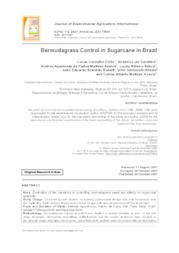Bermudagrass control in sugarcane in Brazil.
Bermudagrass control in sugarcane in Brazil.
Author(s): CIRILO, L. C.; CERDEIRA, A. L.; AZANIA, A. A. P. M.; BELUCI, L. R.; BONETI, J. E. B.; BIDÓIA, V. S.; AZANIA, C. A. M.
Summary: Abstract: Aims: Evaluation of the chemicals in controlling bermudagrass weed and effects on sugarcane selectivity. Study Design: Chamber growth studies: completely randomized design with nine treatments with five replicates. Field studies: Randomized block design with nine treatments with five replicates Place and Duration of Study: Instituto Agronômico, Centro de Cana, São Paulo State, Brazil, between February/2018 and December/2019. Methodology: Bermudagrass chemical control was studied in growth chamber in pots. In the first stage, imazapyr, clomazone, indaziflam, sulfentrazone and the control treatment were studied. In the second stage, imazapyr, clomazone, indaziflam were applied and a treatment with no herbicides was maintained. After 75 days of imazapyr application and 38 days of clomazone and indaziflam, clomazone + indaziflam and clomazone + sulfentrazone were applied, in addition to the control treatment. Sugar cane selectivity study was carried out in the field. Before sugarcane planting, imazapyr, clomazone, indaziflam were applied. After planting, clomazone + indaziflam and clomazone + sulfentrazone were applied, in addition to the control treatment. Results: Clomazone at 1050.0 g ha-1 applied as pre plant at 38 days before planting followed by clomazone at 1050.0 g ha-1 plus sulfentrazone at 650.0 g ha-1 applied 2 days after sugar cane planting was the best treatment for bermudagrass control and yield of the crop. Other viable options for control involved clomazone plus sulfentrazone used after imazapyr or indaziflam.
Publication year: 2021
Types of publication: Journal article
Unit: Embrapa Environment
Observation
Some of Embrapa's publications are published as ePub files. To read them, use or download one of the following free software options to your computer or mobile device. Android: Google Play Books; IOS: iBooks; Windows and Linux: Calibre.
Access other publications
Access the Agricultural Research Database (BDPA) to consult Embrapa's full library collection and records.
Visit Embrapa Bookstore to purchase books and other publications sold by Embrapa.

